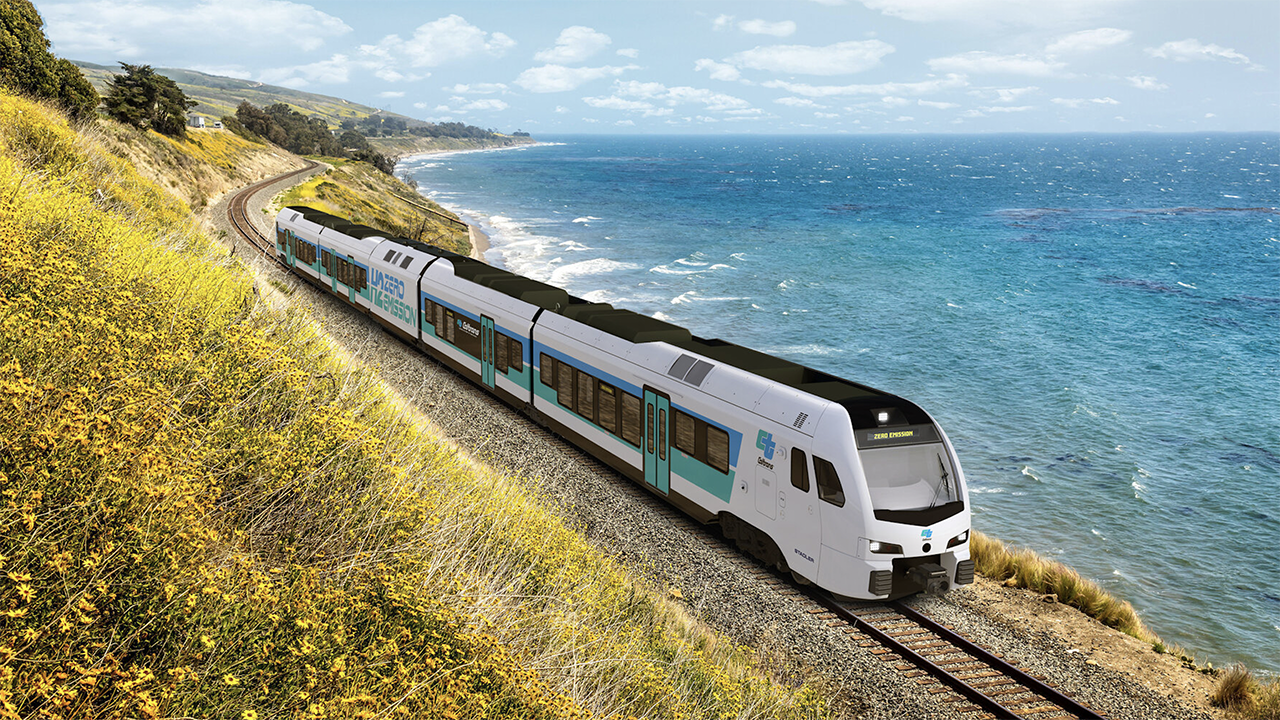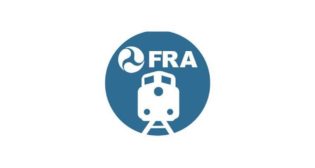
California Finalizes Order for 29 HFC Trainsets
Written by Marybeth Luczak, Executive Editor
The state of California and Stadler have signed a contract for four hydrogen-powered trainsets, “marking a significant step towards a sustainable, emissions-free future for the Golden State,” Stadler reported in an Oct. 12 LinkedIn post. (Rendering Courtesy of Stadler)
Stadler on Oct. 12 signed an agreement with the state of California to supply four zero-emission HFC (hydrogen fuel cell) four-car FLIRT H2 trainsets to the California State Transportation Agency (CalSTA) and the California Department of Transportation (Caltrans), with the option for 25 more.
This follows the group’s September 2022 Memorandum of Understanding for HFC trainsets that was signed at InnoTrans 2022 in Berlin, Germany.
The $80 million contract will be funded through California Gov. Gavin Newsom’s $10 billion, multi-year zero-emission vehicle package, which included $407 million for CalSTA “to demonstrate and purchase or lease state-of-the-art clean bus and rail equipment and infrastructure,” Caltrans reported.
The new trainsets will be based on the initial two-car hydrogen-powered trainset ordered by San Bernardino County (Calif.) Transportation Authority (SBCTA) from Stadler in 2019 that was built in Switzerland and showcased at InnoTrans 2022. It arrived in the U.S. last month and was on display at APTA EXPO 2023, which was held Oct. 9-11 in Orlando, Fla. (see below). This equipment, called ZEMU (Zero-Emission Multiple Unit) by SBCTA, is slated to enter service in 2024 on the nine-mile, five-station San Bernardino Transit Center-University of Redlands (Arrow) line, which began operations last October. The ZEMU will run alongside the current low-emission Stadler FLIRT DMUs.
According to Stadler, the ZEMU has undergone “extensive testing” in both Switzerland and the United States, and the “successful trials” helped lead to the Oct. 12 contract. (For more on testing, read “First U.S. Hydrogen Powered Passenger Trainset Testing at TTC,” by Boris Nejikovsky, Special Advisor, and Matt DeGeorge, Senior Railway Research Engineer at ENSCO, Inc.; and Lucy Andre, Chief of Staff at Stadler US Inc.)
The new contract represents the “next phase” in Stadler’s collaboration with the state of California, “introducing a further developed” ZEMU with “enhanced transport capacity,” the railcar manufacturer said. When the Memorandum of Understanding was signed, it was reported that the four new HFC trainsets would be longer intercity versions of the ZEMU. Built at Stadler’s factory in Salt Lake City, Utah, they would be designed with a 497-mile operating range in between refueling.
According to the Oct. 12 announcement, the new equipment can be used throughout California. “While the base order of trains is expected to primarily operate between Merced and Sacramento on the expanded San Joaquin and Altamont Corridor Express Valley Rail services that will also connect with the early high-speed rail service between Merced and Bakersfield, the trains will also be demonstrated on corridors throughout the state in coordination with intercity and regional rail partners,” Caltrans reported.
“Our design of the battery fuel cell train is changing the U.S. rolling stock industry for alternative propulsion systems, combining the typical Stadler top quality and reliability,” Stadler US CEO Martin Ritter said during the contract announcement. “We’re driving innovation that’s not just transforming railways, but the very essence of sustainable transportation in America. This contract is a testament to our relentless pursuit of sustainable, eco-friendly transportation solutions, and we are thrilled to play a pivotal role in California’s journey towards a cleaner, greener future.”
“California is once again leading the country in delivering innovative clean transportation options that benefit people and the planet,” said Toks Omishakin, California Transportation Secretary. “These state-of-the-art hydrogen train sets will demonstrate the capability of an emerging technology and will complement our future electrified high-speed rail line for an expanded clean rail network.”
“California is using our transportation dollars to fund innovation solutions like these zero-emission, hydrogen passenger trains to significantly reduce planet-warming pollution and combat and adapt to climate change―while providing travelers an alternative to driving,” Caltrans Director Tony Tavares said.



